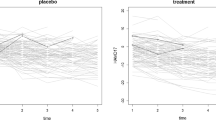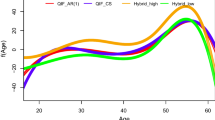Abstract
We extend the approach introduced by Aitkin and Alfò (1998, Statistics and Computing, 4, pp. 289–307) to the general framework of random coefficient models and propose a class of conditional models to deal with binary longitudinal responses, including unknown sources of heterogeneity in the regression parameters as well as serial dependence of Markovian form.
Furthermore, we discuss the extension of the proposed approach to the analysis of informative drop-outs, which represent a central problem in longitudinal studies, and define, as suggested by Follmann and Wu (1995, Biometrics, 51, pp. 151–168), a conditional specification of the full shared parameter model for the primary response and the missingness indicator. The model is applied to a dataset from a methadone maintenance treatment programme held in Sydney in 1986 and previously analysed by Chan et al. (1998, Australian & New Zealand Journal of Statistics, 40, pp. 1–10).
All of the proposed models are estimated by means of an EM algorithm for nonparametric maximum likelihood, without assuming any specific parametric distribution for the random coefficients and for the drop-out process.
A small scale simulation work is described to explore the behaviour of the extended approach in a number of different situations where informative drop-outs are present.
Similar content being viewed by others
References
Akaike H. 1973. Information theory and an extension of the maximum likelihood principle. In: Petrov B.N. and Csaki F. (Eds.), Second International Symposium on Information Theory. Akademiai Kiado, Budapest, pp. 267–281.
Aitkin M. 1999. A general maximum likelihood analysis of variance components in generalized linear models. Biometrics 55: 117–128.
Aitkin M. and Aitkin I. 1996. A hybrid EM/Gauss-Newton algorithm for maximum likelihood in mixture distributions. Statistics and Computing 6: 127–130.
Aitkin M. and Alfo, M. 1998. Regression models for binary longitudinal responses. Statistics and Computing 4: 289–307.
Chan J.S.K., Kuk A.Y.C., Bell J., and McGilchrist C. 1998. The analysis of methadone clinic data using marginal and conditional logistic models with mixture or random effects. Australian & New Zealand Journal of Statistics 40: 1–10.
Dempster A.P., Laird N.M., and Rubin D.A. 1977. Maximum likelihood estimation from incomplete data via the EM algorithm (with discussion). Journal of Royal Statistical Society B 39: 1–38.
Fitzmaurice G.M., Clifford P., and Heath A.F. 1996. Logistic regression models for binary panel data with attrition. Journal of Royal Statistical Society A 159: 249–263.
Follmann D. and Wu M. 1995. An approximate generalized linear model with random effects for informative missing data. Biometrics 51: 151–168.
Fotouhi A.R. and Davies R.B. 1996. Modelling repeated durations: the initial conditions problem. In: Forcina A., Marchetti G.M., Hatzinger R., and Galmacci G. (Eds.), Statistical Modelling. Graphos, Citt`a di Castello, pp. 159–166.
Hsiao C. 1986. Analysis of Panel Data. Cambridge University Press, Cambridge.
Laird N.M. 1978. Nonparametric maximum likelihood estimation of a mixing distribution. Journal of American Statistical Association 73: 805–811.
Leroux B.G. 1992. Consistent estimation of a mixing distribution. Annals of Statistics 20: 1350–1360.
Lindsay B.G. 1983a. The geometry of mixture likelihoods: a general theory. Annals of Statistics 11: 86–94.
Lindsay B.G. 1983b. The geometry of mixture likelihoods, part II: the exponential family. Annals of Statistics 11: 783–792.
Louis T.A. 1982. Finding the observed information matrix when using the EM algorithm. Journal of Royal Statistical Society B 44: 226–233.
Author information
Authors and Affiliations
Rights and permissions
About this article
Cite this article
Alfò, M., Aitkin, M. Random coefficient models for binary longitudinal responses with attrition. Statistics and Computing 10, 279–287 (2000). https://doi.org/10.1023/A:1008999824193
Issue Date:
DOI: https://doi.org/10.1023/A:1008999824193




